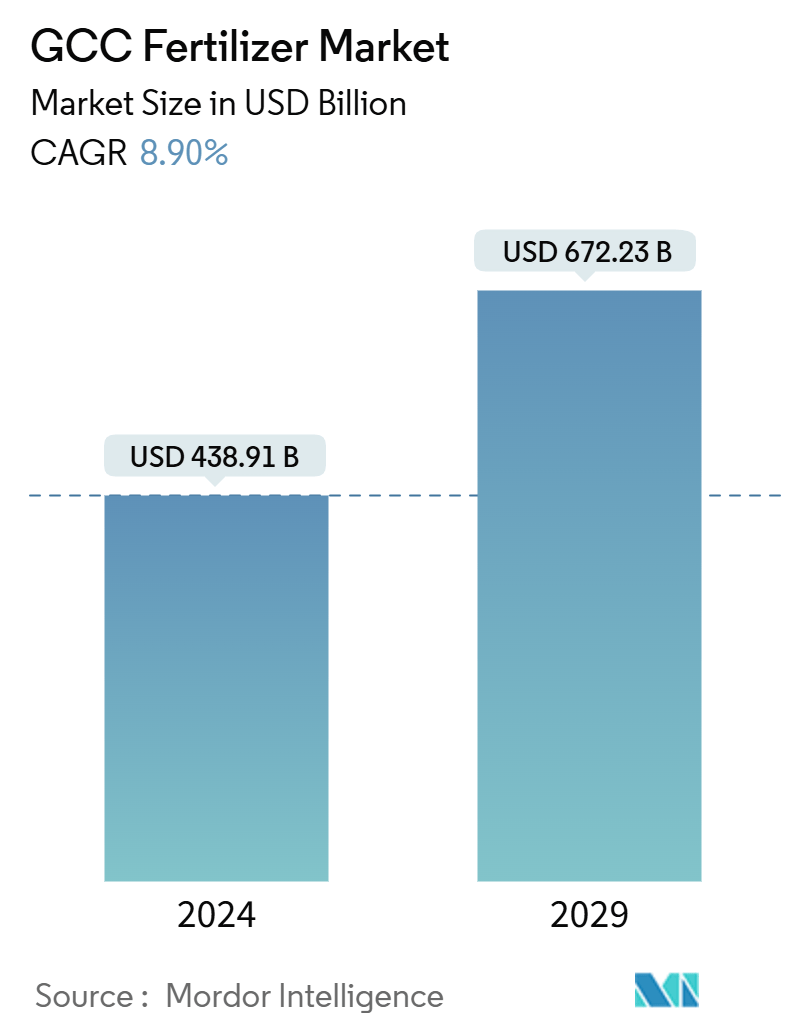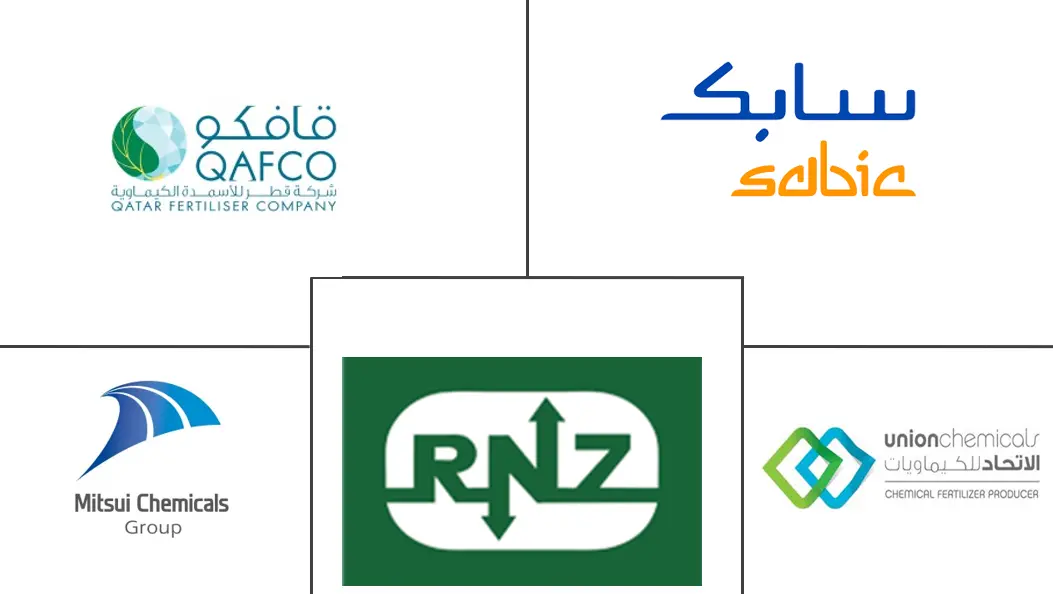Market Size of GCC Fertilizer Industry

| Study Period | 2019 - 2029 |
| Base Year For Estimation | 2023 |
| Market Size (2024) | USD 438.91 Billion |
| Market Size (2029) | USD 672.23 Billion |
| CAGR (2024 - 2029) | 8.90 % |
| Market Concentration | Low |
Major Players
*Disclaimer: Major Players sorted in no particular order |
GCC Fertilizer Market Analysis
The GCC Fertilizer Market size is estimated at USD 438.91 billion in 2024, and is expected to reach USD 672.23 billion by 2029, at a CAGR of 8.90% during the forecast period (2024-2029).
Fertilizers are indispensable for enhancing agricultural productivity, supplying vital nutrients that boost crop yields and improve the quality of produce, including food grains, vegetables, and fruits. The increasing demand for food, along with greater awareness among farmers about the benefits of fertilizers, drives the market. Additionally, rising international demand for fertilizers is stimulating the production of fertilizers in the GCC countries. According to the FAOSTAT, Saudi Arabia produced 55.9 million metric tons of urea in 2021, which increased to 56.0 million metric tons in 2022.
The arid climate of the GCC region, marked by scant rainfall, poses significant challenges for natural soil nutrient replenishment. To counteract this, fertilizers play a crucial role, supplying essential nutrients that boost agricultural productivity, even under the region's harsh conditions. Data from the Food and Agricultural Organisation reveals that Saudi Arabia's agricultural consumption of NPK fertilizers rose to 520,000 metric tons in 2022, up from 490,000 metric tons in 2021. Additionally, the Umm Wu'al Phosphate Project in Saudi Arabia, recognized as the world's largest phosphate production facility, not only produces vast quantities of phosphate annually but also engages in mining, processing, and producing phosphoric acid.
Furthermore, fruit and vegetable production in the GCC region has been expanding as governments focus on achieving self-sufficiency. In 2023, the UAE unveiled its National Food Security Strategy 2051, with ambitions to rank among the top 10 on the Global Food Security Index by 2021 and clinch the top spot by 2051. The strategy emphasizes sustainable food production through modern technologies, bolstering local output, and forging international partnerships for diverse food sourcing. In the United Arab Emirates, fruit production has notably increased over the past two years. According to FAOSTAT, fruit production volumes rose from 407,435.3 metric tons in 2021 to 424,491.1 metric tons in 2022. This uptick in vegetable production has, in turn, spurred a heightened demand for fertilizers, propelling market growth during the forecast period.
GCC Fertilizer Industry Segmentation
Fertilizers are natural or artificial substances containing chemical elements that improve the growth and productivity of plants. The GCC fertilizer Market is segmented by Product Type (Nitrogenous, Phosphatic, Potassic Fertilizers, Secondary Nutrients Fertilizers, and Micronutrient fertilizers), Application (Grains and Cereals, Pulses and Oilseeds, Fruits and Vegetables, Commercial Crops, and Other Applications), and Geography (Saudi Arabia, United Arab Emirates, Qatar, Oman, and the Rest of GCC). The report offers market size and forecasts in terms of value (USD) for the above segments.
| Product type | ||||||||
| ||||||||
| ||||||||
| ||||||||
| Secondary Nutrient Fertilizers | ||||||||
| Micronutrient Fertilizers |
| Application | |
| Grains and Cereals | |
| Pulses and Oil Seeds | |
| Fruits and Vegetables | |
| Commercial Crops | |
| Other Applications |
| Geography | |
| Saudi Arabia | |
| Qatar | |
| Oman | |
| United Arab Emirates | |
| Rest of GCC |
GCC Fertilizer Market Size Summary
The GCC fertilizer market is poised for significant growth, driven by increasing demand for food grains and heightened awareness among farming communities about the benefits of fertilizers in enhancing agricultural productivity. The region's fertilizer industry is closely linked to economic activities and is influenced by factors such as fluctuations in feedstock prices and growth in end-user industries. The COVID-19 pandemic initially posed challenges, impacting the economy and causing a decline in fertilizer prices. However, the subsequent focus on developing local food sources and achieving self-sufficiency in fruit and vegetable production has bolstered the market. Saudi Arabia, a major contributor to the region's fertilizer production, is enhancing its agricultural sector as part of Vision 2030, aiming to increase efficiency and develop rural areas.
The market is characterized by a fragmented landscape with key players such as Qatar Fertilizer Company, Saudi Arabian Fertilizer Company, and Gulf Petrochemical Industries Company leading the charge. The nitrogenous fertilizer segment dominates the market, although the application of potassic fertilizers is rapidly growing due to their potential in improving plant resilience to abiotic stress. The GCC region is also witnessing increased fertilizer exports, with India emerging as a significant market. Strategic investments and partnerships, such as those by SABIC Agri-Nutrients Company and JAS Global Industries, are further enhancing production capabilities and expanding market presence. The industry's positive growth trajectory is supported by increased production capacity and an evolving product portfolio, positioning the GCC fertilizer market for continued expansion.
GCC Fertilizer Market Size - Table of Contents
-
1. MARKET DYNAMICS
-
1.1 Market Overview
-
1.2 Market Drivers
-
1.2.1 Increasing Export to Global Market
-
1.2.2 Continuous Research and Developmnet in GCC region
-
1.2.3 Rising Government Support
-
-
1.3 Market Restraints
-
1.3.1 Regulatory and Environmental Constraints
-
1.3.2 Falling Commodity Prices
-
-
1.4 Porter's Five Forces Analysis
-
1.4.1 Threat of New Entrants
-
1.4.2 Bargaining Power of Buyers/Consumers
-
1.4.3 Bargaining Power of Suppliers
-
1.4.4 Threat of Substitute Products
-
1.4.5 Intensity of Competitive Rivalry
-
-
-
2. MARKET SEGMENTATION
-
2.1 Product type
-
2.1.1 Nitrogenous
-
2.1.1.1 Urea
-
2.1.1.2 Calcium Ammonium Nitrate (CAN)
-
2.1.1.3 Ammonium Nitrate
-
2.1.1.4 Ammonium Sulfate
-
2.1.1.5 Ammonia
-
2.1.1.6 Other Nitrogenous Fertilizers
-
-
2.1.2 Phosphatic
-
2.1.2.1 Mono-ammonium Phosphate (MAP)
-
2.1.2.2 Di-ammonium Phosphate (DAP)
-
2.1.2.3 Triple Superphosphate (TSP)
-
2.1.2.4 Other Phosphatic Fertilizers
-
-
2.1.3 Potassic
-
2.1.3.1 Muriate of Potash (MOP)
-
2.1.3.2 Sulfate of Potash (SOP)
-
-
2.1.4 Secondary Nutrient Fertilizers
-
2.1.5 Micronutrient Fertilizers
-
-
2.2 Application
-
2.2.1 Grains and Cereals
-
2.2.2 Pulses and Oil Seeds
-
2.2.3 Fruits and Vegetables
-
2.2.4 Commercial Crops
-
2.2.5 Other Applications
-
-
2.3 Geography
-
2.3.1 Saudi Arabia
-
2.3.2 Qatar
-
2.3.3 Oman
-
2.3.4 United Arab Emirates
-
2.3.5 Rest of GCC
-
-
GCC Fertilizer Market Size FAQs
How big is the GCC Fertilizer Market?
The GCC Fertilizer Market size is expected to reach USD 438.91 billion in 2024 and grow at a CAGR of 8.90% to reach USD 672.23 billion by 2029.
What is the current GCC Fertilizer Market size?
In 2024, the GCC Fertilizer Market size is expected to reach USD 438.91 billion.

